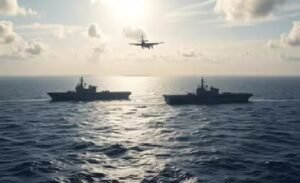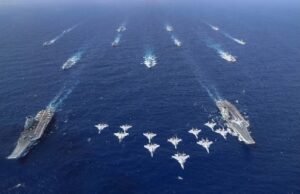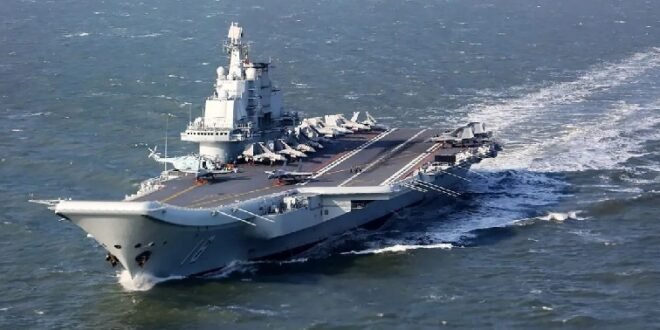11-06-2025
TOKYO: Two Chinese aircraft carriers have been seen operating in the Pacific at once for the first time, Japan’s Ministry of Defence has said.
China’s Shandong and four other vessels on Monday sailed within Japan’s exclusive economic zone (EEZ), the Defence Ministry said on Tuesday.
 The aircraft carrier conducted landing and takeoff drills involving its fighter jets and helicopters in waters north of the Pacific atoll of Okinotori, the ministry said.
The aircraft carrier conducted landing and takeoff drills involving its fighter jets and helicopters in waters north of the Pacific atoll of Okinotori, the ministry said.
Tokyo’s announcement came a day after Japanese officials said the Liaoning, the older of China’s two operating aircraft carriers, had entered waters near the remote island of Minamitorishima.
Japanese Chief Cabinet Secretary Yoshimasa Hayashi said Tokyo would step up surveillance and had conveyed “an appropriate message” to China, without elaborating.
On Monday, Hayashi, who is Tokyo’s top spokesman, said China’s growing maritime activity appeared to be aimed at bolstering its capability to carry out missions farther from its shores.
Chinese Foreign Ministry spokesman Lin Jian on Monday defended the aircraft carriers’ movements, describing them as “fully consistent with international law and international practices”.
“Our national defence policy is defensive in nature. We hope Japan will view those activities objectively and rationally,” Lin told a regular news conference.
On Monday, the Shandong sailed inside the Japanese economic waters surrounding the remote Pacific atoll of Okinotori, Tokyo’s defence ministry said.
It was accompanied by four other vessels including a missile destroyer and fighter jets and helicopters conducted take-offs and landings there, having also been seen sailing through Pacific waters on Saturday.
The ministry previously said that China’s other operational carrier Liaoning and its fleet entered Japan’s exclusive economic zone (EEZ) in the Pacific over the weekend, before exiting to conduct drills involving fighter jets.
 Japanese and US defence officials say China wants to push the American military out of the so-called “first island chain” from Japan down through the Philippines.
Japanese and US defence officials say China wants to push the American military out of the so-called “first island chain” from Japan down through the Philippines.
Eventually, its strategy is to dominate areas west of the “second island chain” in the Pacific between Japan’s remote Ogasawara Islands and the US territory of Guam, they say.
The Liaoning’s recent cruise eastwards marked the first time the Japanese defence ministry has said a Chinese aircraft carrier had crossed the second island chain.
Daisuke Kawai from the University of Tokyo’s economic security research program told media these activities represent “a highly significant strategic escalation”.
“China’s naval incursions into Japan’s EEZ are unquestionably provocative, strategically designed to test Japan’s reaction thresholds without crossing the legal line into outright illegality under international law,” he said.
In September, the Liaoning sailed between two Japanese islands near Taiwan and entered Japan’s contiguous waters, an area up to 24 nautical miles from its coast.
At the time, Tokyo called that move “unacceptable” and expressed “serious concerns” to Beijing.
Under international law, a state has rights to the management of natural resources and other economic activities within its EEZ, which is within 200 nautical miles (370km) of its coastline.
Kawai said the anticipated commissioning of Beijing’s third aircraft carrier, named Fujian, later this year means that “China’s maritime operational tempo and geographic scope of influence will significantly increase”. (Int’l News Desk)
 Pressmediaofindia
Pressmediaofindia




